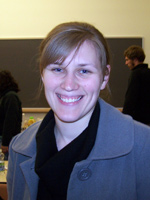2010 Capstone Celebration Symposium
PLU Chemistry Department
May 3rd to May 7th, 2010
Join the Chemistry Department to hear the senior capstone presentations. Student presentations will occur Monday through Friday. The schedule of talks with more details is given below.
[ Monday | Tuesday | Thursday | Friday]
Talks will be held in the Morken Center, Rooms 103 (M, F) and 132 (T, TH)!
Monday, May 3rd, 2010 (Morken Room 103)
12:40 pm - Tetrablock copolymers: Anionic synthesis and compatibilizer effectiveness in a model polymer blend system
Gregory Peterson, Senior Capstone Seminar
Controlled living anionic polymerization was employed to synthesize tetrablock copolymers in order to determine their compatibilizing ability in polymer blends. The tetrablocks were prepared with alternating polystyrene and polybutadiene blocks and goal block molecular weights of 5K and 10K. The copolymers were characterized with GPC and NMR, which demonstrated their monodisperse nature and block content. The tetrablock’s ability to compatibilize blends was examined with cloud point measurements to determine the affect on a blend’s phase boundary temperature, and with atomic force microscopy to qualitatively see the affect of limiting phase separation. The higher molecular weight tetrablock was found to lower the phase transition temperature of a low molecular weight PS/PB blend from 112C to below room temperature with the addition of 8% (w/w) tetrablock, showing that it is an effective compatibilizer. The lower molecular weight tetrablock reduced the phase transition temperature to a much lower degree, likely due to a high vinyl polybutadiene content. Preliminary Atomic Force Microscopy imaging has shown that both tetra blocks reduce the amount of phase separation in a high molecular weight PS/PB blend, but not to a large extent.

1:50 pm - Synthesis of 1,2,3-triazoles in an ionic liquid solvent
Erin Fogarty, Senior Capstone Seminar
The ionic liquid 1-butyl-3-methylimidazolium tetrafluoroborate (BMImBF4), was synthesized in yields of 7-85%. It was found that the most efficient synthesis was a combination of Fang and Creary’s methods, which involved sonication and ion exchange. 1,2,3-Triazoles were then synthesized using copper catalysts in this ionic liquid and compared to synthesis of the same triazoles under standard “click chemistry” conditions in aqueous tert-butanol. The 1,2,3-triazole synthesis had yields of yellow to brown crude solid products ranging from 7- 118% and were likely contaminated by the copper nanoparticles used in their synthesis.

2:30 pm - Progress toward the development of a Wittig olefination catalytic in triphenylarsine: arsenic in “green synthesis”?
Alayne Linde, Senior Capstone Seminar
Triphenylarsine was tested as a catalyst under numerous reaction conditions to approach those favorable for a catalytic Wittig olefination reaction between aromatic aldehydes and an ylide derived from a 2-haloacetophenone derivative. Results of each trial were analyzed through gas chromatography-mass spectrometry (GC-MS), comparing the ratio of percent aldehyde to percent product in order to determine catalyst turnover. While catalytic turnover of triphenylarsine was not reproducibly achieved, important results were obtained relating to reaction pH, reducing agents, solvent effects, temperature, and other reaction conditions.

1:50 pm - Tuning the size of cadmium selenide quantum dots by varying the synthetic and solvent methods
Eric Brauser, Senior Capstone Seminar
In the nanotechnology world, quantum dots are making a stir with their unique optical and electronic properties. Individually they are between 100 and 10000 atoms a piece, and have a diameter around 5 nm. Their small size causes excitons generated from incident light to be confined within the crystal structure and eventually forced to recombine and give off energy in the form of fluorescence. The color light that is emitted is dependent on the size of the nanocrystal, so applications rely on synthetic or post-synthesis methods that return monodisperse quantum dots. A synthetic method was developed by the Bartl group at the University of Utah that proceeds at substantially lower temperatures than the conventional synthesis, which yields better control over the growth and quenching of the quantum dots. Growth optimization was done by varying temperature, solvent volume, surface stabilizing ligands, and precursor injection. The ideal temperature was determined to be 130C and high concentrations of solvent facilitated high concentrations of nanocrystals. The size engineering occurred post-synthesis and used ligands to control the equilibrium between dissolution and growth. Temperature, solvent volume, quantum dot size, and surface ligands were varied to find how they altered the size of the quantum dot sample.

2:30 pm - Synthesis of substituted butadienes as precursors for inverse electron demand Diels-Alder reactions
Jaclyn Lemon, Senior Capstone Seminar
By the hydrostannylation and in situ iododestannylation of 2-butyn-1-ol and 2-butyn-1,4-diol, two vinyl iodides were synthesized for later use in Miyaura-Suzuki cross-coupling reactions. Each reaction required a palladium catalyst to react and was seen to completion through data. The substituted butadienes expected to result from the Miyaura-Suzuki cross-coupling reactions will be used in an inverse electron demand Diels-Alder reaction.

3:20 pm - A greener methylating agent: dimethyl carbonate vs. iodomethane vs. dimethyl sulfate
Liliya Shcherbina, Senior Capstone Seminar
Dimethyl carbonate (DMC), a benign chemical compound that acts as a versatile reactant may be a “greener” chemical reagent in the methylation of anilines, phenols, and carboxylic acids. Recent research supports that DMC is much safer reagent when compared to iodomethane and dimethyl sulfate in these processes.

1:50 pm - Tyrosine kinase inhibitors as selective chemotherapeutic agents
Edmund Valentin, Senior Capstone Seminar
The anti-cancer drug, Tarceva was investigated. Used as either an alternative to chemotherapy, or used as a post-chemotherapy treatment, Tarceva works as a tyrosine kinase inhibitor. By inhibiting ATP phosphorylation at the intracellular tyrosine kinase domain of HER1/EGFR, the aim of Tarceva is to stop the over proliferation of cells that contribute to non-small cell lung cancer.

2:30 pm - Pyrrolobenzodiazepines: Potential Antitumor Activity by DNA Binding as Demonstrated by SJG-136
Emilie Sunde, Senior Capstone Seminar
Pyrrolobenzodiazepines (PBDs) are both naturally occurring and synthetically designed. The first PBD to be discovered, anthramycin, was isolated from the fermentation broth of the Streptomyces species. It has been determined that PBDs form sequence specific bonds within the minor groove of DNA, a trait that makes them potential anti-tumor agents. One PBD dimer of interest is SJG-136, which was synthesized in 1999. It showed high cytotoxicity and has been the subject of many studies. One such study evaluated the bonds formed between SJG-136 and DNA by high performance liquid chromatography (HPLC) coupled with mass spectrometry (MS). Researchers confirmed that SJG-136 forms interstrand cross-links with DNA, as previously hypothesized, and they also discovered that it forms intrastrand cross-links in DNA duplexes. These results have potentially profound affects on the proposed mechanism of action of SJG-136. The compound SJG-136 shows promise in cancer treatment, and it has completed phase 1 clinical trials. Encouraged by SJG-136’s success, researchers are looking for more PBD monomers and dimers that also exhibit cytotoxicity.

3:20 pm - Using sodium perborate as a mild, green oxidant for preparation of epoxy ketones
Nadya Kosanovskaya, Senior Capstone Seminar
In order to develop a reaction of reasonable yield which can be performed in a student laboratory environment and time allowance, a series of different reaction procedures for oxidation of α,β-unsaturated ketones with sodium perborate, a green oxidizing agent, were studied in various protic solvents. Out of 5 performed variations of the synthetic procedures, it was determined that the ketone isophorone reacted with sodium perborate in hexane- or methylene chloride-water mixtures at room temperature and within a 25 minute reaction time resulted in the best yield of 67-70%. The other three reactions did not succeed, based on the changes made in the proposed protocol and are being researched further.

1:10 pm - Triazolium-based ionic liquids: optimized synthesis of novel, `clickable' solvents and determination of some of their physical properties
Jacob Berman, Senior Capstone Seminar
Room temperature ionic liquids (RTILs) are a new class of solvents which offer many benefits over traditional solvents, including negligible volatility, and high reusability, customizability and catalytic activity, inter alia. RTILs have been employed in a diverse range of applications, including electrochemical, bio-organic/pharmaceutical, and industrial processes. In recent years, the vast majority of RTILs studied have been the imidazolium species. Presented in this capstone is the optimized synthesis of recently-described 1,3,4-alkyl-1,2,3-triazolium-based RTILs. which are facilely afforded (yields> 85%) via the [3+2] copper-catalyzed “Click” reaction between an azide and terminal alkyne. The complete synthesis time has been reduced from days to a few hours. Despite RTIL chemistry’s seemingly sanguine future, success with these solvents is predicated on elucidation of all their physical properties. For that reason, studied to measure temperature=dependent surface-tensions, viscosities, and densities of the 1,3,4,-alkyl-1,2,3-triazolium-based RTILs are currently underway in our laboratory.

1:50 pm - Synthesis of N,N’-dihydroxyurea and synthetic derivatives
Melisa Farias, Senior Capstone Seminar
Currently, N-hydroxyurea is the only medication approved to treat sickle cell anemia crises that is effective in only 40% of patients. We are interested in synthesizing related compounds for biological study, including the natural product N,N’-dihydroxyurea (DHU) and its analogs based on drug design by David Mazziotti. Routes to DHU have been previously reported by Weifang et al. using triphosgene (40% yield) and Boyland et al. using phosgene (46%). S,S’-Dimethyldithiocarbonate (DMDTC) was chosen as a convenient precursor which could potentially improve the ease of isolation under aqueous reaction conditions. This reaction has now been optimized, producing the highest reported yield to date (80%). Successful synthesis of a primary amine in the first substitution step with DMDTC has been achieved with a 60% yield. Confirmation provides promise for reaction completion with hydroxylamine in the second substitution step of the synthesis.




Social Media